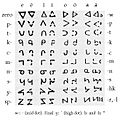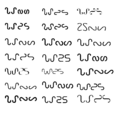Canadian Aboriginal syllabics facts for kids
Canadian syllabic writing, or simply syllabics, is a unique writing system. It was created by a Christian missionary to help write down the languages of some of the First Nations people in Canada. This one writing system later grew into many different ones.
Each symbol in syllabics stands for a whole syllable, not just a single letter. For example, one symbol might mean "pa" or "pi." The symbols often look like triangles and curves. Different languages use slightly different symbols to best show their own sounds.
By the late 1800s, the Cree people had become very good at reading and writing syllabics. They may have had one of the highest rates of people who could read and write anywhere in the world.
Contents
How Canadian Syllabics Began
James Evans was a Methodist missionary from England. He wanted to create an easy way to write for the Cree and Ojibwe people. His goal was to help them learn about Christianity. He found inspiration from the Devanagari alphabet, which is used in India.
How Syllabics Work
In Canadian syllabics, symbols for consonants (like 'p' or 't') keep the same basic shape. What changes is how they are turned or rotated. This rotation tells you which vowel sound goes with the consonant.
For example, all syllables starting with a "p" sound might use a shape like a V.
- If the V shape is upright (ᐯ), it might mean "pe."
- If it's rotated, like ᐸ, it might mean "pa."
This clever system makes it easier to learn and remember the symbols.
Writing Final Sounds
Sometimes, words end with a consonant, like the "t" sound in "cat." To show these final sounds, a smaller symbol is added at the end of the word. This small symbol represents just the consonant sound.
Special Marks in Syllabics
Some languages use small marks, called diacritics, with their syllabic symbols. These marks can show things like how long a vowel sound should be. For example, a mark might tell you to say "ah" instead of "a."
Languages That Use Syllabics
Many First Nations and Inuit languages have used or still use Canadian syllabics. Here are some of them:
Blackfoot Syllabics
The Blackfoot language also adapted syllabics for its own sounds.
Carrier Syllabics
The Carrier language, spoken in British Columbia, developed its own version of syllabics.
Cree Syllabics
The Cree language was one of the first to use syllabics. It became very popular among Cree speakers.
Inuktitut Syllabics
Syllabics is one of the official writing systems in Nunavut, a territory in northern Canada. This means that government papers and signs in Inuktitut can be written in two ways:
- Using the regular Latin alphabet (the ABCs we use).
- Using the special syllabic symbols.
You can often see syllabics on buildings and signs in Nunavut.
Naskapi Syllabics
The Naskapi language, spoken in Quebec and Labrador, also uses syllabics.
Ojibwe Syllabics
The Ojibwe language was another early adopter of syllabics, alongside Cree.
Slavey Syllabics
The Slavey language, spoken in the Northwest Territories, also has its own syllabic system.
Images for kids
See also
 In Spanish: Silabarios indígenas canadienses para niños
In Spanish: Silabarios indígenas canadienses para niños









